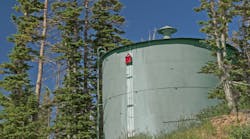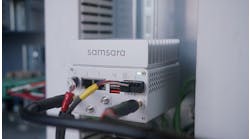After taking on responsibilities for nine surrounding districts, Cobb Area Water District in Lake County, Calif., turned to remote monitoring to provide a more efficient and cost-effective way to monitor tank levels and prevent costly pump burn-outs. Enabled by Samsara, the new monitoring system has delivered the following benefits:
- Real-time monitoring and alerts of tank levels reduces labor and overtime costs thanks to fewer on-site visits.
- Power monitoring with a view of historical data provides an early indicator of pump failures reducing replacement costs.
- Supervisory control allows Cobb to operate pumps and adjust setpoints remotely improving responsiveness.
- Mobile access allows operators to respond to alerts and issues much faster.
Meet Cobb Area Water District
In 2015, after a devastating wildfire left nine neighboring districts unable to stand on their own, the decision was made to roll them into the Cobb Area Water District. With their customer base and geographic footprint effectively doubling overnight, Ben Murphy, general manager at Cobb, knew he could no longer afford to rely on daily truck rolls to monitor tank levels and pump sites—the labor and pump replacement costs would simply be too high.
After exploring a number of SCADA system alternatives, Murphy landed on using Samsara’s cloud-based software and Industrial Gateways (IGs) for remote monitoring and control of Cobb’s water network. Today, in addition to their gains in operator efficiency and reduction in both labor and maintenance costs, Murphy finds the system providing additional value as Cobb continues to rebuild and grow.
Improving efficiency with remote monitoring
Faced with an expanded footprint as well as significant infrastructure repairs after the wildfire, it was time for Cobb to rethink its reliance on daily manual inspections. “We were driving to our tanks every single day because the cost of SCADA was so high that it just never made sense for us. But taking this on for nine more districts was going to be a massive lift,” said Murphy “We went from monitoring five water sources before the merge to 18, with some sites over 10 miles apart. That’s when we started looking at remote monitoring."
Prioritizing safety and labor costs, Cobb kicked off their project with a focus on tank level monitoring across their network. With real-time alerts and access to dashboards for each site from their cell phones, operators can monitor tank levels remotely, reducing the number of site visits they have to make.
"When I look at the labor and overtime costs, tank monitoring alone means the system will pay for itself in less than three years.”
If a tank level is too high or if it drops below its set threshold, Murphy and his team get a notification via text message or phone call so they can take steps to remedy the issue immediately.
Reducing maintenance and pump replacement costs
In addition to tank-level monitoring, Cobb is monitoring voltage and amperage across their well pumps. Prior to this, issues would go unnoticed until Cobb’s electric bill spiked, doubling in some cases, or until a pump’s motor burned out and had to be replaced, a $6,000 expense. “One thing I love is that we can monitor our voltages and amperages over time, we can go back and look at the history, see if things are looking different than they were a few days ago, catching problems before one of our pump’s motors burns out,” said Murphy.
Along with maintenance cost reductions, identifying issues early reduces the likelihood of emergency maintenance and the associated risk of service interruptions and downtime. “We don’t have to do our maintenance under the gun, we can plan it so that we make sure our tanks are full before we start and that we’re not missing any important steps,” Murphy said.
Finding additional value in supervisory control
As Cobb steadily rebuilds its infrastructure—upgrading water lines, adding tanks and VFDs—use cases continue to expand. “We’re now seeing everything else we can do–monitoring our VFDs, currents, pressures and operating our pumps too,” said Murphy.
“Before, we had one site where we set up what we thought was one of the lower cost SCADA systems out there, but what we’re learning now is that we can run all of the same control for less than half of that cost. It’s been one thing after another that we realize we can do with the system. We find ourselves regularly asking—how did we do this before without Samsara?”
To learn more about Samsara for remote monitoring or to start a free trial, click here.



